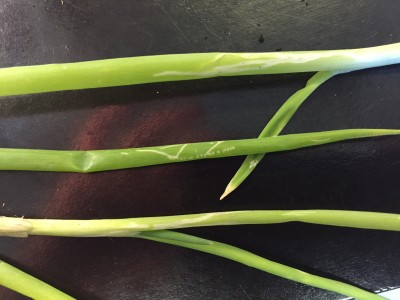Allium Leafminer Spring Flight Has Begun
Ethan Grundberg, Vegetable Specialist
Eastern New York Commercial Horticulture

On Friday, April 27th, Teresa Rusinek confirmed the first signs of adult allium leafminer (ALM) activity on garlic in Ulster County. We anticipate adults will continue to mate and lay eggs on allium crops through the month of May. As the larvae feed on tissue inside of the leaf, they can cause considerable damage to crops like scallions and chives that are marketed with green tops. The physical damage caused by adult oviposition and larval feeding also opens wounds in the leaf tissue that can serve as entry points for other pathogens that cause botrytis leaf blight and soft rot.
We are conducting insecticide efficacy trials this year in conjunction with Cornell entomologist Dr. Brian Nault to better understand which active ingredients are most effective at reducing damage from ALM and also how many applications are necessary for acceptable ALM control. There are a number of insecticides labeled for leafminer control on bulb vegetables: the insect growth regulator cyromazine (Trigard), spinosyns (Radiant, Entrust (OMRI)), and several pyrethroids (Mustang Maxx, Warrior). Note that abamectin products (Agri-Mek), neonicotinoids (Assail, Admire Pro), and cyantraniliprole formulations (Exirel) are labeled ONLY for Liriomyza leafminers and/or thrips, but may be effective at managing ALM. Since allium species have a waxy leaf cuticle, it is highly recommended that insecticides be mixed with a compatible penetrating adjuvant (LI 700, M-Pede (OMRI), etc.) As always, follow the labeled directions for use for any pesticide.
This article is from the May 3, 2018 edition of ENYCHP Vegetable News. To read the full newsletter,CLICK HERE.

Upcoming Events
How to Obtain a Pesticide Applicator License
December 17, 2025
Thinking about becoming a certified pesticide applicator in New York, but aren't sure where to start? Join DEC representative Kenneth Klubek for a discussion on who needs to become a certified pesticide applicator, certification types, examination procedures, and recertification. Participants will have ample opportunity to ask questions during the program.
Ag Labor Road Show IX
December 1, 2025 : Save the Date! - Ag Labor Roadshow Webinar 1
In addition to the in-person Ag Labor Roadshow program in our region on December 9, two webinars are scheduled for December 1 and December 22. Each webinar will focus on different program content that is different from the in-person sessions. These webinars are an added benefit to program registration.
December 9, 2025 : Save the Date - Ag Labor Road Show In-Person Event (Greenwich, NY)
Greenwich, NY
The Roadshow delivers essential updates on labor law, regulations, and workforce best practices—tailored for farm owners, managers, and ag service providers. Sessions also focus on practical strategies to boost communication, strengthen retention, and build a positive workplace culture.
The in-person session for Eastern NY is December 9 - Elks Lodge, Greenwich, NY - full day in person session
Additional in-person sessions are:
December 10 - Hilton Garden Inn, Watertown, NY, December 17 - Cornell AgriTech, Geneva, NY, December 18 - Genesee Community College, Batavia, NY
December 22, 2025 : Save the Date! - Ag Labor Roadshow Webinar 2
In addition to the in-person Ag Labor Roadshow program in our region on December 9, two webinars are scheduled for December 1 and December 22. Each webinar will focus on different program content that is different from the in-person sessions. These webinars are an added benefit to program registration.
2026 Winter Cut Flower Webinar Series
January 6, 2026 : Session 1: Cut Flower Cost Calculator Updates and Woody Cuts
Session 1: Cut Flower Cost Calculator Updates and Woody Cuts
January 13, 2026 : Session 2: Perennials and Industry Trends
Session 2: Perennials and Industry Trends
January 20, 2026 : Session 3: Anaerobic Soil Disinfestation and Biochar
Session 3: Anaerobic Soil Disinfestation and Biochar
January 27, 2026 : Session 4: Beneficial Insects and Propagation Techniques
Session 4: Beneficial Insects and Propagation Techniques
February 3, 2026 : Session 5: Fungal and Insect Pests and Market Trends
Session 5: Fungal and Insect Pests and Market Trends












































